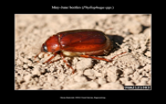May-June Beetles
go.ncsu.edu/readext?798248
en Español / em Português
El inglés es el idioma de control de esta página. En la medida en que haya algún conflicto entre la traducción al inglés y la traducción, el inglés prevalece.
Al hacer clic en el enlace de traducción se activa un servicio de traducción gratuito para convertir la página al español. Al igual que con cualquier traducción por Internet, la conversión no es sensible al contexto y puede que no traduzca el texto en su significado original. NC State Extension no garantiza la exactitud del texto traducido. Por favor, tenga en cuenta que algunas aplicaciones y/o servicios pueden no funcionar como se espera cuando se traducen.
Português
Inglês é o idioma de controle desta página. Na medida que haja algum conflito entre o texto original em Inglês e a tradução, o Inglês prevalece.
Ao clicar no link de tradução, um serviço gratuito de tradução será ativado para converter a página para o Português. Como em qualquer tradução pela internet, a conversão não é sensivel ao contexto e pode não ocorrer a tradução para o significado orginal. O serviço de Extensão da Carolina do Norte (NC State Extension) não garante a exatidão do texto traduzido. Por favor, observe que algumas funções ou serviços podem não funcionar como esperado após a tradução.
English
English is the controlling language of this page. To the extent there is any conflict between the English text and the translation, English controls.
Clicking on the translation link activates a free translation service to convert the page to Spanish. As with any Internet translation, the conversion is not context-sensitive and may not translate the text to its original meaning. NC State Extension does not guarantee the accuracy of the translated text. Please note that some applications and/or services may not function as expected when translated.
Collapse ▲May Beetles are also called June bugs because they are particularly active during summer, usually around the porch light. This beetle is not the big green June bug – but we’ll be seeing them later on, too. There are many species in the Phyllophaga genus and they look like each other in many ways, though some are darker than others. The May-June beetle has a sturdy, oblong, brown body with shiny wing covers (elytra) protecting their wings. With jointed brown legs they can get a powerful grip on window screens and door frames.
They are not dangerous to people, but they used to be agricultural pests in orchards, groves, sod farms, and crops and as part of the white grub pest pool, their larvae can be a nuisance.
White grubs are the larvae of scarab beetles, an insect family with about 30,000 different member species in a number of subfamilies and tribes. All these grubs  have cream-colored bodies with yellow to brownish heads, brownish hind parts, and six legs. Mature grubs vary in length from 1⁄4 to 1 1⁄2 inches, depending on the species. White grubs usually lie in a curled or C-shaped position. The May-June beetle larvae feed on roots and decaying vegetation in the soil, while the adults feed on leave of various plants.
have cream-colored bodies with yellow to brownish heads, brownish hind parts, and six legs. Mature grubs vary in length from 1⁄4 to 1 1⁄2 inches, depending on the species. White grubs usually lie in a curled or C-shaped position. The May-June beetle larvae feed on roots and decaying vegetation in the soil, while the adults feed on leave of various plants.
Just as the adult beetles are not all the same, control of their larvae takes a different approach too. Milky spore is a biological treatment method, but it only works on the Japanese beetle grub. The goal of pest management is integrated pest management (IPM), to keep damage to an acceptable level while using  monitoring and appropriate control tactics. It’s an approach that uses knowledge about pests and their life cycles, cultural practices, nonchemical methods, and pesticides to manage pest problems. Chemical treatment is a last resort and comes with its own disadvantages. Read more about IPM
monitoring and appropriate control tactics. It’s an approach that uses knowledge about pests and their life cycles, cultural practices, nonchemical methods, and pesticides to manage pest problems. Chemical treatment is a last resort and comes with its own disadvantages. Read more about IPM
If the chemical approach is selected, the timing of the insecticide application is critical if control is to be effective. There are two approaches, preventative and curative. Preventative techniques are most effective when applied prior to when the eggs are laid, used in areas that have a history of grub infestations. The curative approach is used when an existing infestation is detected. The best time to apply curative insecticides is when the grubs are actively feeding near the soil surface. Pesticides applied any other time will be ineffective. This feeding occurs from August through October, and again in April through early May. Curative treatments applied in late summer or fall are usually more effective than spring applications because the grubs are small. Specific timing depends on the species of grub, and on location in the state.
Read more: White Grubs in Turf
Minda Daughtry is the Horticulture Agent for North Carolina Cooperative Extension in Lee County




